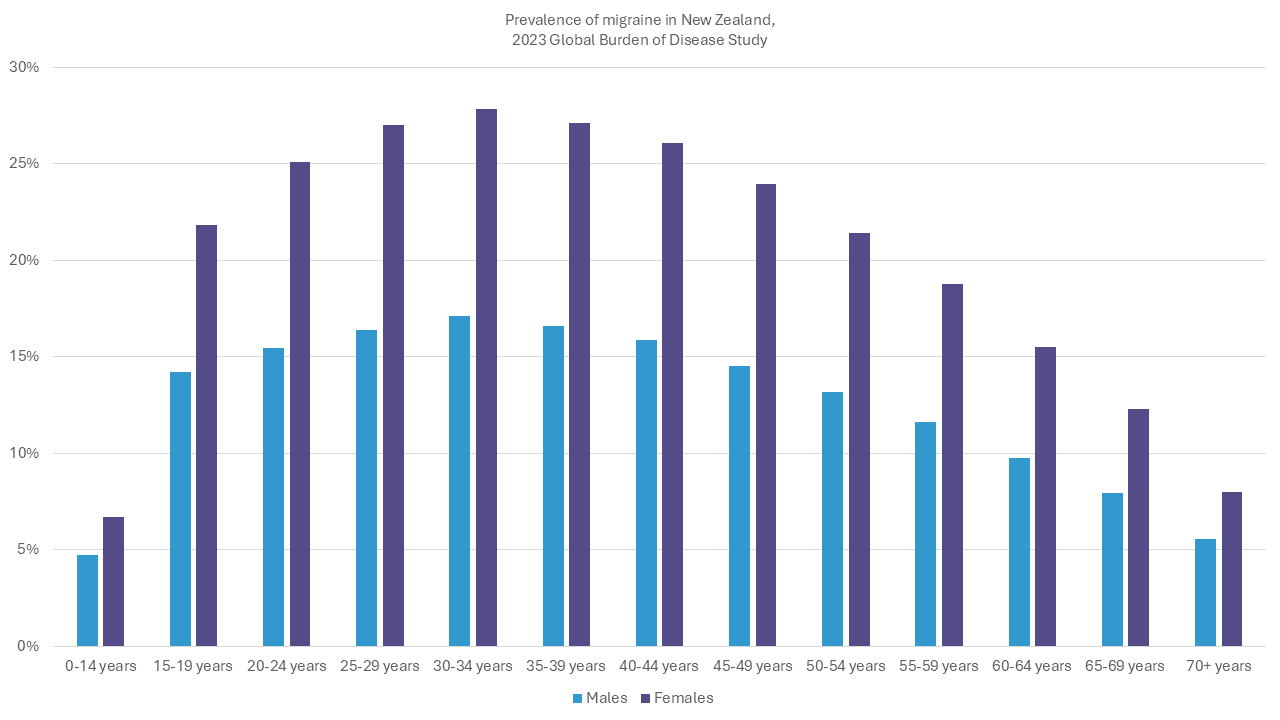For many health conditions in Aotearoa New Zealand, including migraine, there is limited regular, consistent or robust data collection on prevalence of disease. This means we don’t know as much as we would like to about the number of people who have migraine, particularly the number of Māori, Pacific and Asian people with migraine or whether migraine affects more people in different locations or with different access to resources.
However, we do have estimates from the Global Burden of Disease (GBD) study. This is an international research project that draws on data from around the world to estimate and compare the prevalence, mortality and disability impact of a large range of diseases, including migraine. This gives us numbers of people with migraine in NZ by age and gender, based on projections and results from other countries where there are not good data sources in this country. Migraine is assumed to NOT cause deaths or contribute to mortality, so the burden measured is that of ‘years lived with disability’ (YLD).
The GBD study has just updated its database for 2023, and these results supersede those that came before. Although no new prevalence data for migraine were added, there was a key refinement to how YLD was calculated, which now includes an adjustment for both duration and frequency of migraine attacks. This adjustment means that the burden of migraine, measured by YLD, is now estimated to be a little more than double (2.1 times greater) in females compared to males, because females with migraine spend more time with headache than males (previous estimates were a little lower at 1.6 times greater). Another change in this version of the GBD is that they now estimate how much of the migraine burden is due to medication overuse headache – and they put this at 15%. This should be preventable and deserves more recognition.
For NZ, 733,000 people were estimated to have migraine in 2023 (453,000 females and 280,000 males), which is a little less than the 2021 estimate of 753,000. The slight decline can be attributed to the new estimate using actual Census data, rather than projections from the previous Census, which were a little optimistic in their predictions of population growth.
According to the GBD, the overall prevalence of migraine in NZ is 15% (18% in females and 12% in males), which is the same as the global estimate – affecting around one in every 7 people. A new analysis of prevalence data, which pooled together only studies with a standardised assessment of headache in those aged 18-65 years, estimates that one in four people (25%) experience migraine in the last year. In females, this is closer to one in three (30%). That’s a lot of migraine.
References
Global Burden of Disease Collaborative Network. Global Burden of Disease Study 2023 (GBD 2023) Results. Seattle, United States: Institute for Health Metrics and Evaluation (IHME), 2024. Available from https://vizhub.healthdata.org/gbd-results/.
Husøy, A., Steiner, T. GBD 2023: over twice the health loss from headache disorders among females compared with males, and one fifth of the loss is attributable to medication overuse. J Headache Pain 26, 227 (2025). https://doi.org/10.1186/s10194-025-02192-z
Husøy, A.K., Yu, S., Liu, R. et al. The global prevalence of headache disorders of public-health importance: a meta-analysis of population-based individual participant data from 41,614 adults from 17 countries. J Headache Pain 26, 204 (2025). https://doi.org/10.1186/s10194-025-02142-9
GBD 2023 Disease and Injury and Risk Factor Collaborators. Burden of 375 diseases and injuries, risk-attributable burden of 88 risk factors, and healthy life expectancy in 204 countries and territories, including 660 subnational locations, 1990-2023: a systematic analysis for the Global Burden of Disease Study 2023. Lancet. 2025 Oct 18;406(10513):1873-1922. doi: 10.1016/S0140-6736(25)01637-X.


